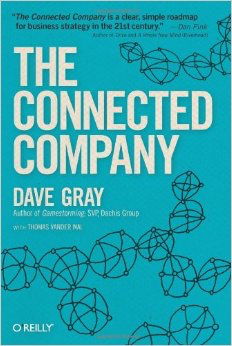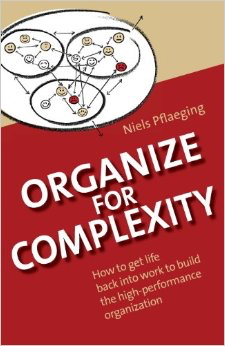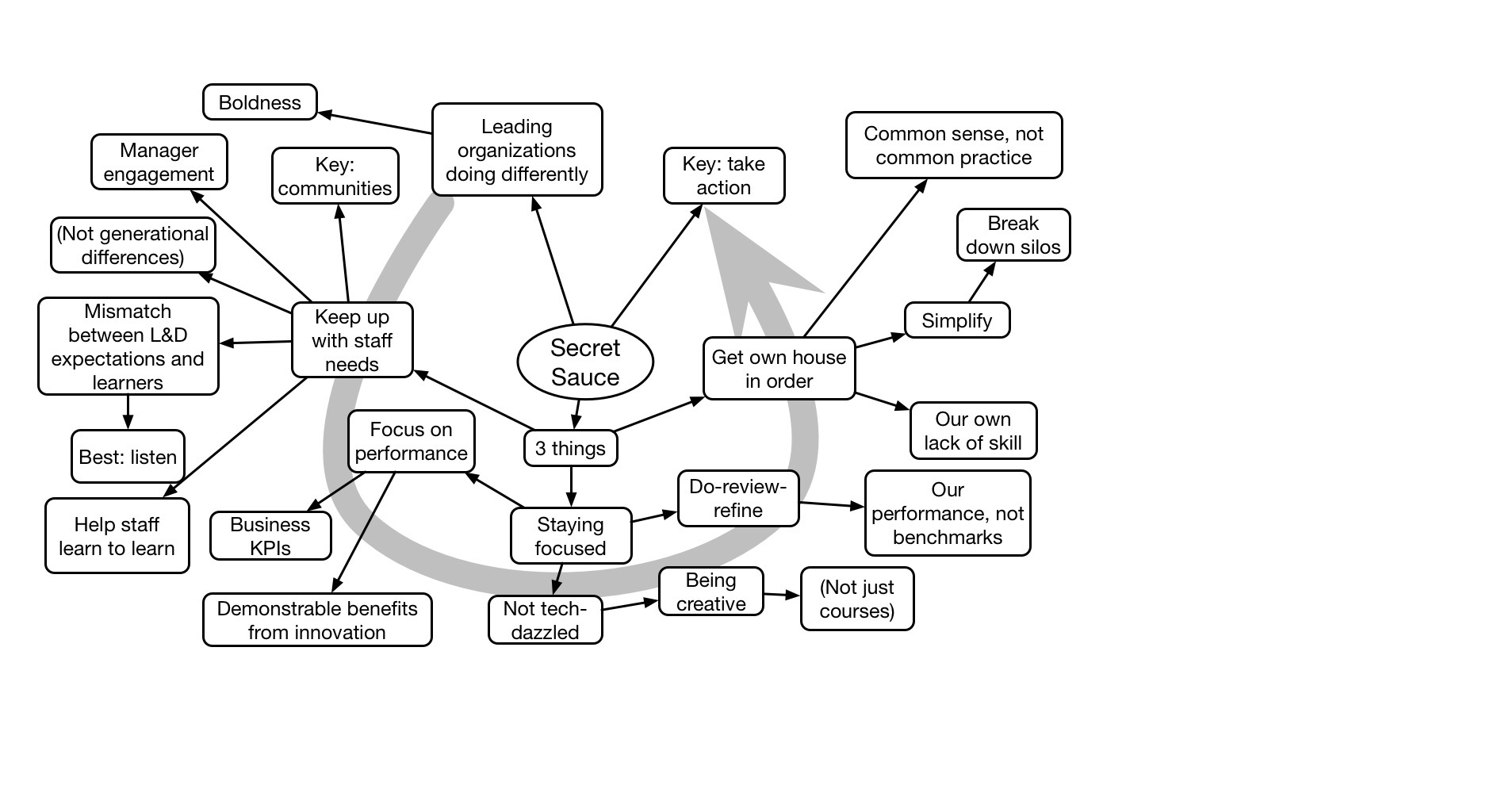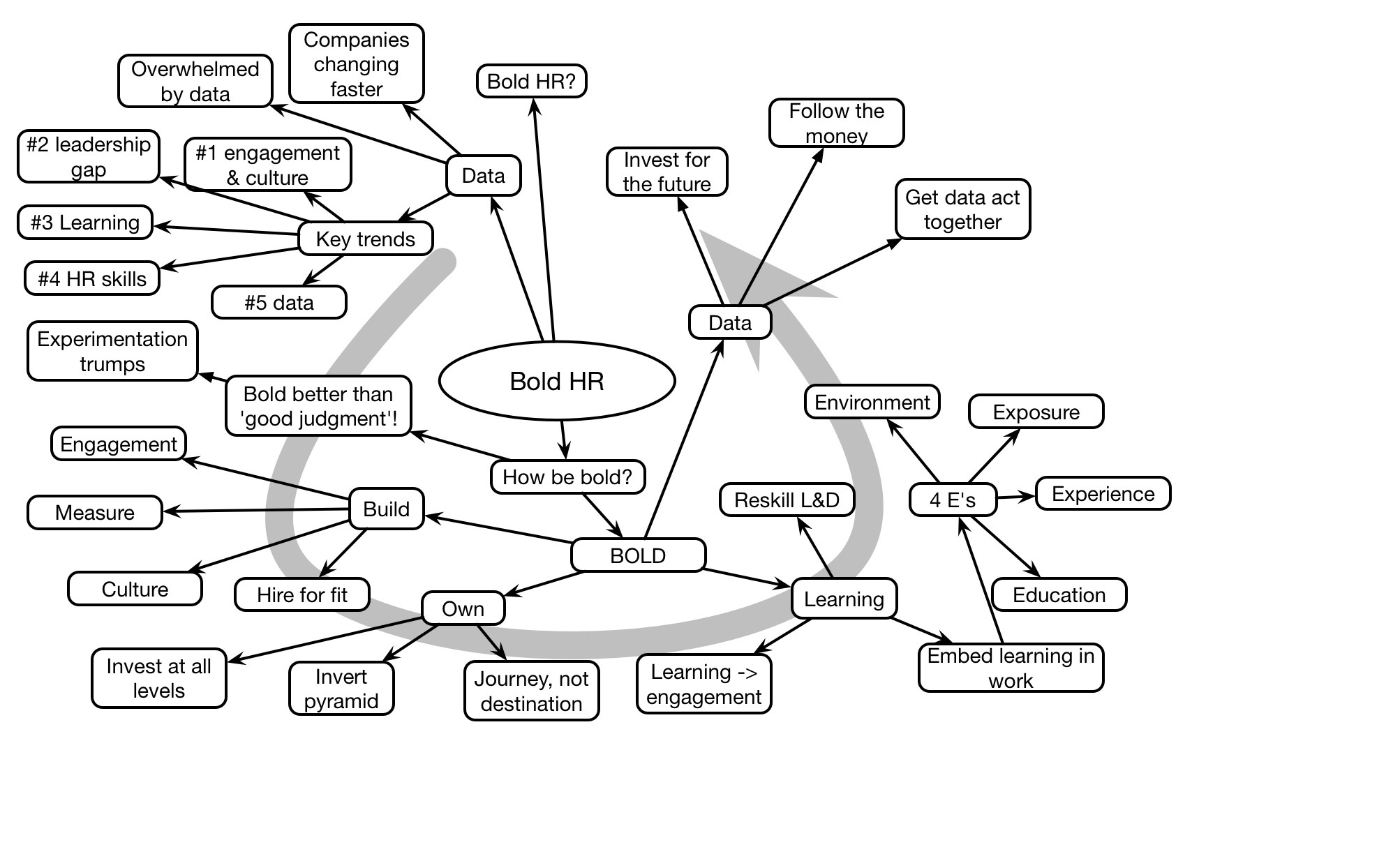Laura used Towards Maturity data to provide insight into how leading L&D organizations are making their way.
David Mallon #learnatworkau Plenary Mindmap
Learning by experimenting
In some recent work, an organization is looking to find a way to learn fast enough to cope with the increasing changes we’re seeing. Or, better yet, learn ahead of the curve. And this led to some thoughts.
As a starting point, it helps to realize that adapting to change is a form of learning. So, what are the individual equivalents we might use as an analogy? Well, in known areas we take a course. On the other hand, for self-learning, e.g. when there isn’t a source for the answer, we need to try things. That is, we need a cycle of: do – review -refine.
In the model of a learning organization, experimentation is clearly listed as a component of concrete learning processes and practices. And my thought was that it is therefore clear that any business unit or community of practice that wants to be leading the way needs to be trying things out.
I’ve argued before that learning units need to be using new technologies to get their minds around the ‘affordances’ possible to support organizational performance and development. Yet we see that far too few organizations are using social networks for learning (< 30%), for example.
If you’re systematically tracking what’s going on, determining small experiments to trial out the implications, documenting and sharing the results, you’re going to be learning out ahead of the game. This should be the case for all business units, and I think this is yet another area that L&D could and should be facilitating. And by facilitating, I mean: modeling (by doing it internally), evangelizing, supporting in process, publicizing, rewarding, and scaling.
I think the way to keep up with the rate of change is to be driving it. Or, as Alan Kay put it: “the best way to predict the future is to invent it”. Yes, this requires some resources, but it’s ultimately key to organizational success, and L&D can and should be the driver of the process within the organization.
The new shape of organizations?
As I read more about how to create organizations that are resilient and adaptable, there’s an interesting emergent characteristic. What I’m seeing is a particular pattern of structure that has arisen out of totally disparate areas, yet keeps repeating. While I haven’t had a chance to think about it at scale, like how it would manifest in a large organization, it certainly bears some strengths.
 Dave Grey, in his recent book The Connected Company that I reviewed, has argued for a ‘podular’ structure, where small groups of people are connected in larger aggregations, but work largely independently. He argues that each pod is a small business within the larger business, which gives flexibility and adaptiveness. Innovation, which tends to get stifled in a hierarchical structure, can flourish in this more flexible structure.
Dave Grey, in his recent book The Connected Company that I reviewed, has argued for a ‘podular’ structure, where small groups of people are connected in larger aggregations, but work largely independently. He argues that each pod is a small business within the larger business, which gives flexibility and adaptiveness. Innovation, which tends to get stifled in a hierarchical structure, can flourish in this more flexible structure.
 More recently, on Harold Jarche‘s recommendation, I read Niels Pflaeging’s Organize for Complexity, a book also on how to create organizations that are high performance. While I think the argument was a bit sketchy (to be fair, it’s deliberately graphic and lean), I was sold on the outcomes, and one of them is ‘cells’ composed of a small group of diverse individuals accomplishing a business outcome. He makes clear that this is not departments in a hierarchy, but flat communication between cross-functional teams.
More recently, on Harold Jarche‘s recommendation, I read Niels Pflaeging’s Organize for Complexity, a book also on how to create organizations that are high performance. While I think the argument was a bit sketchy (to be fair, it’s deliberately graphic and lean), I was sold on the outcomes, and one of them is ‘cells’ composed of a small group of diverse individuals accomplishing a business outcome. He makes clear that this is not departments in a hierarchy, but flat communication between cross-functional teams.
And, finally, Stan McChrystal has a book out called Team of Teams, that builds upon the concepts he presented as a keynote I mindmapped previously. This emerged from how the military had to learn to cope with rapid changes in tactics. Here again, the same concept of small groups working with a clear mission and freedom to pursue emerges.
This also aligns well with the results implied by Dan Pink’s Drive, where he suggests that the three critical elements for performance are to provide people with important goals, the freedom to pursue them, and support to succeed. Small teams fit well within what’s known about the best in getting the best ideas and solutions out of people, such as brainstorming.
These are nuances on top of Jon Husband’s Wirearchy, where we have some proposed structure around the connections. It’s clear that to become adaptive, we need to strengthen connections and decrease structure (interestingly, this also reflects the organizational equivalents of nature’s extremophiles). It’s about trust and purpose and collaboration and more. And, of course, to create a culture where learning is truly welcomed.
Interesting that out of responding to societal changes, organizational work, and military needs, we see a repeated pattern. As such, I think it’s worth taking notice. And there are clear L&D implications, I reckon. What say you?
#itashare
The Polymath Proposition
At the recent DevLearn conference, one of the keynotes was Adam Savage. And he said something that gave me a sense of validation. He was talking about being a polymath, and I think that’s worth understanding.
His point was that his broad knowledge of a lot of things was valuable. While he wasn’t the world’s expert in any particular thing, he knew a lot about a lot of things. Now if you don’t know him, it helps to understand that he’s one of the two hosts of Mythbusters, a show that takes urban myths and puts them to the test. This requires designing experiments that fit within pragmatic constraints of cost and safety, and will answer the question. Good experiment design is an art as well as a science, and given the broad range of what the myths cover, this ends up requiring a large amount of ingenuity.
The reason I like this is that my interests vary broadly (ok, I’m coming to terms with a wee bit of ADD ;). The large picture is how technology can be designed to help us think, work, and learn. This ends up meaning I have to understand things like cognition and learning (my Ph.D. is in cognitive psychology), computers (I’ve programmed and designed architectures at many levels), design (I’ve looked at usability, software engineering, industrial design, architectural design, and more), and organizational issues (social, innovation…). It’s led to explorations covering things like games, mobile, and strategy (e.g. the topics of my books). And more; I’ve led development of adaptive learning systems, content models, learning content, performance support, social environments, and so on. It’s led me further, too, exploring org change and culture, myth and ritual, engagement and fun, aesthetics and media, and other things I can’t even recall right now.
And I draw upon models from as many fields as I can. My Ph.D. research was related to the power of models as a basis for solving new problems in uncertain domains, and so I continue to collect them like others collect autographs or music. I look for commonalities, and try to make my understanding explicit by continuing to diagram and write about my reflections. I immodestly think I draw upon a broad swath of areas. And I particularly push learning to learn and meta-cognition to others because it’s been so core to my own success.
What I thrive on is finding situations where the automatic solutions don’t apply. It’s not just a clear case for ID, or performance support, or… Where technology can be used (or used better) in systemic ways to create new opportunities. Where I really contribute is where it’s clear that change is needed, but what, how, and where to start aren’t obvious. I’ve a reliable track record of finding unique, and yet pragmatic solutions to such situations, including the above named areas I’ve innovated in. And it is a commitment of mine to do so in ways that pass on that knowledge, to work in collaboration to co-develop the approach and share the concepts driving it, to hand off ownership to the client. I’m not looking for a sinecure; I want to help while I’m adding value and move on when I’m not. And many folks have been happy to have my assistance.
It’s hard for me to talk about myself in this way, but I reckon I bring that polymath ability of a broad background to organizations trying to advance. It’s been in assisting their ability to develop design processes that yield better learning outcomes, through mobile strategies and solutions that meet their situation, to overarching organizational strategies that map from concepts to system. There’s a pretty fair track record to back up what I say.
I am deep in a lot of areas, and have the ability to synthesize solutions across these areas in integrated ways. I may not be the deepest in any one, but when you need to look across them and integrate a systemic solution, I like to think and try to ensure that I’m your guy. I help organizations envision a future state, identify the benefits and costs, and prioritize the opportunities to define a strategy. I have operated independently or with partners, but I adamantly retain my freedom to say what I truly think so that you get an unbiased response from the broad suite of principles I have to hand. That’s my commitment to integrity.
I didn’t intend this to be a commercial, but I did like his perspective and it made me reflect on what my own value proposition is. I welcome your thoughts. We now return you to your regularly scheduled blog already in progress…
Buy this…for your boss
So I’ve been pushing an L&D Revolution, and for good reasons. I truly believe that L&D is on a path to extinction because: “it isn’t doing near what it could and should, and what it is doing, it is doing badly, otherwise it’s fine” (as my mantra would have it). So many bad practices – info-dump and knowledge-test classes, no alternative to courses, lack of measuring impact – mean that L&D is out of touch with the information age. And what with everyone being able to access the web, content creation tools, and social media environments, wherever and whenever they are, people can survive and thrive without what L&D does, and are doing so.
What I’ve argued is that we need to align with how we really think, work, and learn, and bring that to the organization. What L&D could be doing – providing a rich performance ecosystem that not only empowers optimal execution, but foster the necessary continual innovation – is a truly deep contribution to the success of the organization.
I feel so strongly that I wrote a book about it. If you’ve read it, you know it documents the problems, provides framing concepts, is illustrated with examples, and promotes a roadmap forward (if you’ve read and liked it, I’d love an Amazon review!). And while it’s both selling reasonably well (as far as I can tell, the information from my publisher is impenetrable ;) and leading to speaking opportunities, I fear it’s not getting to the right people. Frankly, most of my speaking and writing has been at the practitioner and manager level, and this is really for the director, and up! All the way to the C-suite, potentially. And while I make an effort to get this idea into their vision, there’s a lot of competition, because everyone wants the C-suite’s attention.
The point I want to make is that the real audience for this book is your boss (unless you’re the CEO, of course ;). And I’m not saying this to sell books (I’m unlikely to make more than enough to buy a couple of cups of coffee off the proceeds, given book contracts), but because I think the message is so important!
So, let me implore you to consider somehow getting the revolution in front of your boss, or your grandboss, and up. It doesn’t have to be the book, but the concept really needs to be understood if the organization is going to remain competitive. All evidence points to the fact that organizations have to become more agile, and that’s a role L&D is in a prime position to facilitate. If, however (and that’s a big if), they get the bigger picture. And that’s the message I’m trying to spread in all the ways I can see. I welcome your thoughts, and your assistance even more.
David Pogue #DevLearn Keynote Mindmap
David Pogue addressed the DevLearn audience on Learning Disruption. In a very funny and insightful presentation, he ranged from the Internet of Things, thru disintermediation and wearables, pointing out disruptive trends. He concluded by talking about the new generation and the need to keep trying new things. 
Revolution Roadmap: Assess
Last week, I wrote about a process to follow in moving forward on the L&D Revolution. The first step is Assess, and I’ve been thinking about what that means. So here, let me lay out some preliminary thoughts.
The first level are the broad categories. As I’m talking about aligning with how we think, work, and learn, those are the three top areas where I feel we fail to recognize what’s known about cognition, individually and together. As I mentioned yesterday, I’m looking at how we use technology to facilitate productivity in ways specifically focused on helping people learn. But let me be clear, here I’m talking about the big picture of learning – problem-solving, design, research, innovation, etc – as they call fall under the category of things we don’t know the answer to when we begin.
I started with how we think. Too often we don’t put information in the world when we can, yet we know that all our thinking isn’t in our head. So we can ask :
- Are you using performance consulting?
- Are you taking responsibility for resource development?
- Are you ensuring the information architecture for resources is user-focused?
The next area is working, and here the revelation is that the best outcomes come from people working together. Creative friction, when done in consonance with how we work together best, is where the best solutions and the best new ideas will come from. So you can look at:
- Are people communicating?
- Are people collaborating?
- Do you have in place a learning culture?
Finally, with learning, as the area most familiar to L&D, we need to look at whether we’re applying what’s known about making learning work. We should start with Serious eLearning, but we can go farther. Things to look at include:
- Are you practicing deeper learning design?
- Are you designing engagement into learning?
- Are you developing meta-learning?
In addition to each of these areas, there are cross-category issues. Things to look at for each include:
- Do you have infrastructure?
- What are you measuring?
All of these areas have nuances underneath, but at the top level these strike me as the core categories of questions. This is working down to a finer grain than I looked at in the book (c.f. Figure 8.1), though that was a good start at evaluating where one is.
I’m convinced that the first step for change is to understand where you are (before the next step, Learn, about where you could be). I’ve yet to see many organizations that are in full swing here, and I have persistently made the case that the status quo isn’t sufficient. So, are you ready to take the first step to assess where you are?
Biz tech
One of my arguments for the L&D revolution is the role that L&D could be playing. I believe that if L&D were truly enabling optimal execution as well as facilitating continual innovation (read: learning), then they’d be as critical to the organization as IT. And that made me think about how this role would differ.
To be sure, IT is critical. In today’s business, we track our business, do our modeling, run operations, and more with IT. There is plenty of vertical-specific software, from product design to transaction tracking, and of course more general business software such as document generation, financials, etc. So how does L&D be as ubiquitous as other software? Several ways.
First, formal learning software is really enterprise-wide. Whether it’s simulations/scenarios/serious games, spaced learning delivered via mobile, or user-generated content (note: I’m deliberately avoiding the LMS and courses ;), these things should play a role in preparing the audience to optimally execute and being accessed by a large proportion of the audience. And that’s not including our tools to develop same.
Similarly, our performance support solutions – portals housing job aids and context-sensitive support – should be broadly distributed. Yes, IT may own the portals, but in most cases they are not to be trusted to do a user- and usage-centered solution. L&D should be involved in ensuring that the solutions both articulate with and reflect the formal learning, and are organized by user need not business silo.
And of course the social network software – profiles and locators as well as communication and collaboration tools – should be under the purview of L&D. Again, IT may own them or maintain them, but the facilitation of their use, the understanding of the different roles and ensuring they’re being used efficiently, is a role for L&D.
My point here is that there is an enterprise-wide category of software, supporting learning in the big sense (including problem-solving, research, design, innovation), that should be under the oversight of L&D. And this is the way in which L&D becomes more critical to the enterprise. That it’s not just about taking people away from work and doing things to them before sending them back, but facilitating productive engagement and interaction throughout the workflow. At least at the places where they’re stepping outside of the known solutions, and that is increasingly going to be the case.
Agile?
Last Friday’s #GuildChat was on Agile Development. The topic is interesting to me, because like with Design Thinking, it seems like well-known practices with a new branding. So as I did then, I’ll lay out what I see and hope others will enlighten me.
As context, during grad school I was in a research group focused on user-centered system design, which included design, processes, and more. I subsequently taught interface design (aka Human Computer Interaction or HCI) for a number of years (while continuing to research learning technology), and made a practice of advocating the best practices from HCI to the ed tech community. What was current at the time were iterative, situated, collaborative, and participatory design processes, so I was pretty familiar with the principles and a fan. That is, really understand the context, design and test frequently, working in teams with your customers.
Fast forward a couple of decades, and the Agile Manifesto puts a stake in the ground for software engineering. And we see a focus on releasable code, but again with principles of iteration and testing, team work, and tight customer involvement. Michael Allen was enthused enough to use it as a spark that led to the Serious eLearning Manifesto.
That inspiration has clearly (and finally) now moved to learning design. Whether it’s Allen’s SAM or Ger Driesen’s Agile Learning Manifesto, we’re seeing a call for rethinking the old waterfall model of design. And this is a good thing (only decades late ;). Certainly we know that working together is better than working alone (if you manage the process right ;), so the collaboration part is a win.
And we certainly need change. The existing approaches we too often see involve a designer being given some documents, access to a SME (if lucky), and told to create a course on X. Sure, there’re tools and templates, but they are focused on making particular interactions easier, not on ensuring better learning design. And the person works alone and does the design and development in one pass. There are likely to be review checkpoints, but there’s little testing. There are variations on this, including perhaps an initial collaboration meeting, some SME review, or a storyboard before development commences, but too often it’s largely an independent one way flow, and this isn’t good.
The underlying issue is that waterfall models, where you specify the requirements in advance and then design, develop, and implement just don’t work. The problem is that the human brain is pretty much the most complex thing in existence, and when we determine a priori what will work, we don’t take into account the fact that like Heisenberg what we implement will change the system. Iterative development and testing allows the specs to change after initial experience. Several issues arise with this, however.
For one, there’s a question about what is the right size and scope of a deliverable. Learning experiences, while typically overwritten, do have some stricture that keeps them from having intermediately useful results. I was curious about what made sense, though to me it seemed that you could develop your final practice first as a deliverable, and then fill in with the required earlier practice, and content resources, and this seemed similar to what was offered up during the chat to my question.
The other one is scoping and budgeting the process. I often ask, when talking about game design, how to know when to stop iterating. The usual (and wrong answer) is when you run out of time or money. The right answer would be when you’ve hit your metrics, the ones you should set before you begin that determine the parameters of a solution (and they can be consciously reconsidered as part of the process). The typical answer, particularly for those concerned with controlling costs, is something like a heuristic choice of 3 iterations. Drawing on some other work in software process, I’d recommend creating estimates, but then reviewing them after. In the software case, people got much better at estimates, and that could be a valuable extension. But it shouldn’t be any more difficult to estimate, certainly with some experience, than existing methods.
Ok, so I may be a bit jaded about new brandings on what should already be good practice, but I think anything that helps us focus on developing in ways that lead to quality outcomes is a good thing. I encourage you to work more collaboratively, develop and test more iteratively, and work on discrete chunks. Your stakeholders should be glad you did.

